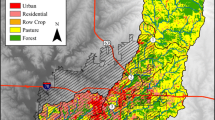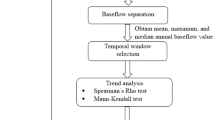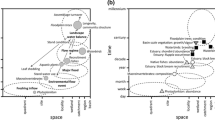Abstract
Two new methods for assessing temporal trends in stream-solute concentrations at specific streamflow ranges were applied to long (40 to 50-year) but sparse (bi-weekly to quarterly sampling) stream-water quality data collected at three forested mesoscale basins along an atmospheric deposition gradient in the northeastern United States (one in north-central Pennsylvania, one in southeastern New York, and one in eastern Maine). The three data sets span the period since the implementation of the Clean Air Act in 1970 and its subsequent amendments.
Declining sulfate (O 4 2-) trends since the mid 1960s were identified for all 3 rivers by one or more of the 4 methods of trend detection used. Flow-specific trends were assessed by segmenting the data sets into 3-year and 6-year blocks, then determining concentration-discharge relationships for each block. Declining sulfate (O 4 2-) trends at median flow were similar to trends determined using a Seasonal Kendall Tau test and Sen slope estimator. The trend of declining O 4 2- concentrations differed at high, median and low flow since the mid 1980s at YWC and NR, and at high and low flow at WR, but the trends leveled or reversed at high flow from 1999 through 2002. Trends for the period of record at high flows were similar to medium- and low-flow trends for Ca2++ Mg2+ concentrations at WR, non-significant at YWC, and were more negative at low flow than at high flow at NR; trends in nitrate (NO3 -), and alkalinity (ALK) concentrations were different at different flow conditions, and in ways that are consistent with the hydrology and deposition history at each watershed. Quarterly sampling is adequate for assessing average-flow trends in the chemical parameters assessed over long time periods (∼decades). However, with even a modest effort at sampling a range of flow conditions within each year, trends at specified flows for constituents with strong concentration-discharge relationships can be evaluated and may allow early detection of ecosystem response to climate change and pollution management strategies.
Similar content being viewed by others
References
Aber, J. D., Nadelhoffer, K. J., Steudler, P. and Melillo, J. M.: 1989, ‘Nitrogen saturation in northern forest ecosytems’, Bioscience 39, 378–1989.
Aulenbach, B. A. and Hooper, R. P.: ‘The composite method: An improved method for streamwater solute load estimation’, Hydrological Processes (in press).
Aulenbach, B. T., Hooper, R. P. and Bricker, O. P.: 1996, ‘Trends in precipitation and surface-water chemistry in a national network of small watersheds’, Hydrol. Process. 10(2), 151–181.
Baldigo, B. P.: 1999, ‘Trends in Base Flows and Extreme Flows in the Beaver Kill Basin, Catskill Mountains, New York, 1915–1994’, USGS Open-File Rep. 98–65, 17p.
Burns, D. A., McHale, M.R., Driscoll, C. T., and Roy, K. M.: 2005, ‘Response of surface water chemistry to reduced levels of acid precipitation: comparison of trends in two regions of New York, USA’, Hydrol. Process., 19, in press.
Clow, D. W. and Mast, M. A.: 1999, ‘Long-term trends in streamwater and precipitation chemistry at five headwater basins in the northeastern United States’, Water Resour. Res. 35(2), 541–554.
Driscoll, C. T., Lawrence, G. B., Bulger, A. J., Butler, T. J., Cronan, C. S., Eager, C., Lambert, K. F., Likens, G. E., Stoddard, J. L. and Weathers, K. C.: 2001, ‘Acidic deposition in the Northeastern United States: Sources and inputs, ecosystem effects, and management strategies’, BioScience 51(3), 180–198.
Fishman, M. J. and Friedman, L. C., 1989, Methods for Determination of Inorganic Substances in Water and Fluvial Sediments: U.S. Geological Survey Techniques of Water-Resources Investigations, book 5, Chap. A1, 545 p.
Gran, G.: 1952, ‘Determination of the equivalence point in potentiometric titrationns – Part II’, Analyst, 77, 661–671.
Helsel, D. R. and Hirsch, R. M.: 1992, Statistical Methods in Water Resources, Elsevier, New York, 522 p.
Hirsch, R. M., Slack, J. R. and Smith, R. A.: 1982, ‘Techniques of trend analysis for monthly water quality data’, Water Res. Res. 18(1), 107–121.
Hodgkins, G. A., Dudley, R. W. and Huntington, T. G.: 2003, ‘Changes in the timing of high river flows in New England over the 20th century’, J. Hydrol. 278(1), 244–252.
Huntington, T. G., Hooper, R. P. and Aulenbach, B. T.: 1994, ‘Hydrologic processes controlling SO4 2− mobility in a small forested watershed’, Water Resour. Res. 30, 283–295.
Johnson, N. M., Likens, G. E., Bormann, F. H., Fischer, D. W. and Pierce, R. S.: 1969 ‘A working model for the variation in streamwater chemistry at the Hubbard Brook Experimental Forest, New Hampshire’, Water Resour. Res. 5(6), 1353–1363.
Kristensen, P. and Brand, J.: 1996 ‘Surface water quality monitoring’, European Environment Agency Topic Report 2/1996, at http://reports.eea.eu.int/92–9167-001-4/en, discontinuous pagination.
Lawrence, G. B., Lincoln, T. A., Horan-Ross, D. A., Olson, M. L. and Waldron, L. A.: 1995, ‘Analytical methods of the US Geological Survey'2 New York District water analysis laboratory’, USGS Open-File Rep. 95–416. 78 p.
Lawrence, G. B., Burns, D. A., Baldigo, B. P., Murdoch, P. S. and Lovett, G. M.: 2001, ‘Controls of stream chemistry and fish populations in the Neversink Watershed, Catskill Mountains, New York’, USGS Water Resour. Invest. Rep. 00–4040, 16p.
Lewis, W. M.: 2002, ‘Yield of nitrogen from minimally-disturbed watersheds of the United States’, Biogeochemistry 57, 375–385.
Likens, G. E., Driscoll, C. T. and Buso, D. C., 1996, ‘Long-term effects of acid rain – Response and recovery of a forest ecosystem’, Science 272, 244–246.
Lincoln, T. A., Horan-Ross, D. A., Olson, M. L. and Lawrence, G. B.: 1996, ‘Quality-assurance data for routine water analyses by the U.S. Geological Survey Laboratory in Troy, New York’, USGS Open File Rep. 96–167, 22p.
Lincoln, T. A., Horan-Ross, D. A., Olson, M. L. and Lawrence, G. B.: 2004, Quality-Assurance Data for Routine Water Analyses by the U.S. Geological Survey Laboratory in Troy, New York, USGS Open File Rep. 04–1327, 22p.
Lins, H. and Slack, J. R.: 1999, ‘Streamflow trends in the United States’, Geophysical Research Letters 26, 227–230.
Mast, M. A. and Turk, J. T.: 1999, Environmental Characteristics and Water Quality of Hydrologic Benchmark Network Stations in the Eastern United States, 1963–1995, USGS Circular 1173–A, 158p.
Murdoch, P. S., Burns, D. A. and Lawrence, G. B.: 1998, ‘Relation of climate change to the acidification of surface waters by nitrogen deposition’, Environ. Sci. Techn. 32, 1642–1647.
Murdoch, P. S. and Shanley, J. B., 2005, ‘New methods for assessing trends in water quality at specific flow levels in Biscuit Brook, Catskill Mountains, NY’, Water Resour. Res. in press.
Smith, R. A. and Alexander, R. B.: 1983, ‘Evidence of acid-precipitation induced trends in stream chemistry at hydrologic bench-mark stations’, USGS Circular 910, 15p.
Stoddard, J. L.: 1994, ‘Long-term changes in watershed retention of nitrogen: It'2 causes and aquatic consequences’, in L. A. Baker (ed.), Environmental Chemistry of Lakes and Reservoirs, Amer. Chem. Soc. Advances in Chem. Series 237, ACS, Washington, DC, pp. 223–284.
Stoddard, J. L. and Murdoch, P. S.: 1991, ‘Catskill mountains’, in D. F. Charles (ed.), Acidic Deposition and Aquatic Ecosystems: Regional Case Studies, Springer-Verlag, NY, pp. 237–271.
Stoddard, J. L., Kahl, J. S., Deviney, F. A., DeWalle, D. R., Driscoll, C. T., Herlihy, A. T., Kellog, J. H., Murdoch, P. S., Webb, J. R. and Webster, K. E.: 2003, ‘Response of Surface Water Chemistry to the Clean air Act Amendments of 1990, USEPA Report EPA620/R-03/001, 74 p.
US Geological Survey: 1999, National Field Manual for the Collection of Water Quality Data, USGS Techn. Water Resour. Invest. Book 9, Chapter A4, 105 p.
Van Sickle, J., Baker, J. P., Simonin, H. A., Baldigo, B. P., Kretser, W. A. and Sharpe, W. E.: 1996, ‘Episodic acidification of small streams in the north-eastern United States: Fish mortality in field bioassays’, Ecol. Appl. 6(2), 408–421.
Author information
Authors and Affiliations
Corresponding author
Rights and permissions
About this article
Cite this article
Murdoch, P.S., Shanley, J.B. Flow-Specific Trends in River-Water Quality Resulting from the Effects of the Clean Air Act in Three Mesoscale, Forested River Basins in the Northeastern United States Through 2002. Environ Monit Assess 120, 1–25 (2006). https://doi.org/10.1007/s10661-005-9028-1
Received:
Accepted:
Published:
Issue Date:
DOI: https://doi.org/10.1007/s10661-005-9028-1




